Ncert Solutions Chemistry12 Chapter 1 will help to solve all the questions of Solution. Solution is the part of physical chemistry in which we have to solve mostly numerical questions and they are somewhat tricky. But we have tried our best to solve these problems at easy and interesting level. Students will gain a good approach after taking the help of this solutions notes.
Solution is the homogeneous mixture of two or more unreacting substances. They are impure but have many awesome qualities and properties. The most of the substances we in our daily life are a kind of mixture. Hence Ncert Solutions Chemistry12 Chapter 1 has great importance. This chapter is also useful for competitive and entrance level exams. We should have a good knowledge of this chapter.
Ncert Solutions Chemistry12 Chapter 1 will give answer of 12 intext questions and 41 exercise questions. We should have good practice over the concepts and formulas applied in this chapter. The important theories are Henry’s law, Raoult law, Vant’s Hoff equation and factors. Formulas regarding molarity, molality, mole fraction, ppm, colligative properties. These are the key points to keep remember. Let’s move to solve the problems of this chapter.
Ncert Solutions Chemistry12 Chapter 1: Learning Objectives
- To describe the formation of different types of solution.
- To represent concentration of solution in different units.
- To state and explain Henry’s law and Raoult’s law.
- To distinguish between ideal and non ideal solutions.
- To explain deviations of real solutions from Raoult’s law.
- To describe colligative properties of solutions and correlate these with molar masses of the solute.
- To explain abnormal colligative properties exhibited by same solute in solutions.
Answers and Questions of Ncert Solutions Chemistry12 Chapter 1
Answer of Intext Questions
Question 1. Calculate the mass percentage of benzene (C6H6) and carbon tetrachloride (CCl4) if 22 g of benzene is dissolved in 122 g of carbon tetrachloride.
Answer: Mass of solution = Mass of benzene + mass of carbon tetrachloride = 22 g + 122 g = 144 g. And Mass % of benzene = (Mass of benzene/Mass of solution) × 100 = (22/144) × 100 = 15.28%
Again, Mass % of carbon tetrachloride = (Mass of CCl4/ Mass of solution) × 100 = (122/144) × 100 = 84.22%
Question 2. Calculate the mole fraction of benzene in solution containing 30% by mass in carbon tetrachloride.
Answer: 30% of benzene in CCl4 by mass means that mass of of benzene = 30 g and mass of solution = 100 g ∴ mass of CCl4 = 70 g. Molar mass of benzene (C6H6) = 78 gmol-1 and Molar mass of CCl4 = 12 + 4 × 35.5 = 154 gmol-1 Since, The no of moles of benzene (nC6H6) = 30/78 = 0.385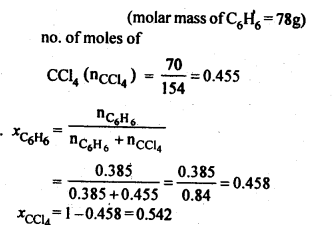
Question 3. Calculate the molarity of each of the following solutions
(a) 30 g of Co(NO3)26H2O in 4·3 L of solution
(b) 30 mL of 0-5 M H2SO4 diluted to 500 mL.
Answer: (a) Molar mass of Co(NO3)2 6H2O = 58.7 + 2(14 + 48) + 6 × 18 gmol-1 = 58.7 + 124 + 128 gmol-1 = 310.7 gmol-1 No of moles of Co(NO3)2 6H2O = Mass/ Molar mass = 30 g/ 310.7 gmol-1 = 0.0966 mol. And Volume of solution = 4.3 L ∴ Molarity of solution = No. of moles of solute/ Volume of solution in L = 0.0966 mole / 4.3 L = 0.022 M.
(b) 1000 mL of 0.5 M H2SO4 contains H2SO4 = 0.5 mole. ∴ 30 mL of 0.5 M H2SO4 contains H2SO4 = (0.5 / 1000) × 30 mole = 0.015 mole. And Volume of solution = 500 mL = 0.5 L ∴ Molarity of solution = No. of moles of solute/ Volume of solution in L = 0.015 mole / 0.5 L = 0.03 M.
Question 4. Calculate the mass of urea (NH2CONH2) required in making 2.5 kg of 0.25 molal aqueous solution.
Answer: 0.25 molal aqueous solution of urea means that Moles of urea = 0.25 mol. Mass of solvent (water) = 1 kg = 1000 g. Molar mass of NH2CONH2 (urea) = 14 + 2 + 12 + 16 +14 + 2 = 60 gmol-1 ∴ 0.25 mole of urea = 0.025 mole × 60 gmol-1 = 15 g. Total mass of solution = 1000 + 15 g = 1015 g = 1.015 kg. Thus, 1.015 kg of solution contains urea = 15 g. ∴ 2.5 kg of solution will require urea = (15 g /1.015 kg) × 2.5 kg = 37 g.
Question 5. 2.5. Calculate
(a) molality
(b) molarity and
(c) mole fraction of KI if the density of 20% (mass/mass) aqueous KI solution is 1·202 g mL-1.
Answer: 20% (mass/mass) aqueous KI solution means that Mass of KI = 20 g. Mass of solution in water = 100 g. ∴ Mass of solvent (water) = 100 – 30 = 70 g (a) calculation of Molality: Molar mass of KI = 39 + 127 = 166 gmol-1 and moles of KI = 20 g/166 gmol-1 = 0.120 ∴ Molarity of solution = No. of moles of KI / Mass of solvent in kg = 0.120 moles / 0.080 kg = 1.5 m.
(b) Calculation of molarity: Density of solution = 1.202 g mL-1 and volume of solution = 100 g / 1.202 g mL-1 = 83.2 mL = 0.0832 L. ∴ molarity of solution = Moles of solute/volume of solution in L = 0.120 mole / 0.0832 L = 1.44 M.
(c) Calculation of mole fraction of KI: NO. Of moles of KI = 0.120 and No of moles of water = Mass of water/ Molar mass of water = 80 g / 18 g mol-1 = 4.44. ∴ Mole fraction of KI = No. of moles of KI / Total no of moles in solution = 0.120 / 0.120 + 4.44 = 0.120 / 4.560 = 0.0263.
Question 6. H2 S, a toxic gas with rotten egg like smell, is used for the qualitative analysis. If the solubility of H2S in water at STP is 0.195 m, calculate Henry’s law constant.
Answer : Solubility of H2S gas = 0.195 m = 0.195 mole in 1 kg of the solvent (water) 1 kg of the solvent (water) = 1000 g = 1000 g / 18 g mol-1 = 55.55 moles. ∴ Mole fraction of H2S gas in the solution (Χ) = 0.195 / 0.195 + 55.55 = 0.195 / 55.745 = 0.0035.
Pressure at STP = 0.967 bar. Now applying Henry’s law, pH2S = kH × xH2S or kH = pH2S/kH2S = 0.987 bar / 0.0035 = 282 bar.
Question 7. Henry’s law constant for CO2 in water is 1.67 x 108 Pa at 298 K. Calculate the quantity of CO2 in 500 mL of soda water when packed under 2.5 atm CO2 pressure at 298 K.
Answer : kH = 1.67 × 108 Pa and PCO2 = 2.5 atm = 2.5 × 101325 Pa. Now applying Henry’s law, PCO2 = KH × xCO2 or xCO2 = PCO2/kH = 3.5 × 101325 pa / 1.67 × 108 Pa = 1.517 × 10–3 due to very low mole fraction of CO2, xCO2 = nCO2 / nH2O = 1.517 × 10–3.
For 500 mL of soda water, water present 500 mL = 500 g = 500/18 =27.78 moles. Now nCO2/27.78 = 1.517 × 10–3 or nCO2 = 42.14 × 10–3 mole = 42.14 × 10–3 × 44 g = 1.854 g.
Question 8. The vapour pressures of pure liquids A and B are 450 mm and 700 mm of Hg respectively at 350 K. Calculate the composition of the liquid mixture if total vapour pressure is 600 mm of Hg. Also find the composition in the vapour phase.
Answer: Here, poA = 450 mm, poB = 700 mm. 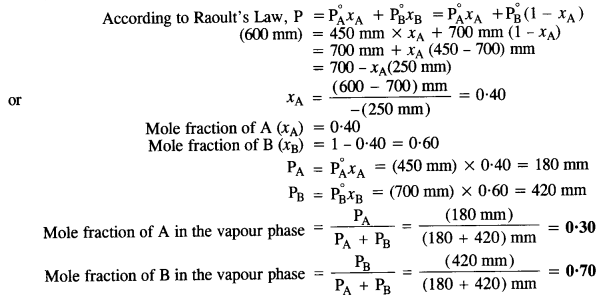
Question 9. Vapour pressure of pure water at 298 K is 23.8 m m Hg. 50 g of urea (NH2CONH2) is dissolved in 850 g of water. Calculate the vapour pressure of water for this solution and its relative lowering.
Answer: Here, 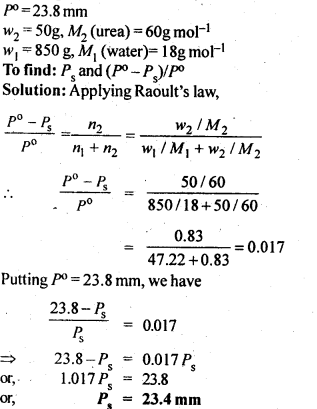
Question 10. Boiling point of water at 750 mm Hg is 99.63°C. How much sucrose is to be added to 500 g of water such that it boils at 100°C.
Answer: 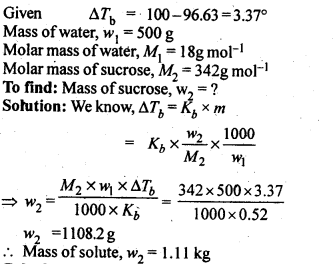
Question 11. Calculate the mass of ascorbic acid (vitamin C, C6H8O6) to be dissolved in 75 g of acetic acid to lower its melting point by 1·5°C. (Kf for CH3COOH) = 3·9 K kg mol-1)
Answer: As we know that 
Question 12. Calculate the osmotic pressure in pascals exerted by a solution prepared by dissolving 1.0 g of polymer of molar mass 185,000 in 450 mL of water at 37°C.
Answer: 
Answer of Exercise Questions in Ncert Solutions Chemistry12 Chapter 1
Question 1. Define the term solution. How many types of solutions are formed? Write briefly about each type with an example.
Answer: A homogeneous mixture of two or more unreacting chemical substance is called solution. A solution containing only one solute dissolved in a solvent is called binary solution.
There are following types of solution depending upon the physical state of the solvent:
- Solid in solid: alloys, german silver, bronze etc.
- Liquid in solid: hydrated salts, amalgam of Hg with Na.
- Gas in solid: dissolved gases in minerals or H2 in Pd.
- Solid in liquid: salt or glucose or sugar solution in water
- Liquid in liquid: Methanol or ethanol in water.
- Gas in liquid: aerated drinks, O2 in water.
- Solid in gas: Iodine vapour in air, camphor in N2 gas.
- Liquid in gas: humidity in air, Chloroform mixed with N2 gas.
- Gas in gas: air (N2 + O2).
Question 2. Suppose a solid solution is formed between two substances, one whose particles are very large and the other whose particles are very small. What type of solid solution is this likely to be ?
Answer: Interstitial solution can be likely this.
Question 3. Define the following terms:
(i) Mole fraction
(ii) Molality
(iii) Molarity
(iv) Mass percentage
Answer : (i) Mole fraction. The moles of any component present in per mole of solution is called mole fraction. It is denoted by “χ”. If a solution is made of two components A and B and their no. of moles are nA and nB respectively then mole fraction of A (χA) = nA/(nA +nB) and mole fraction of B (χB) = nB/(nA + nB).
(ii) Molality. The moles of solute dissolved in per kilogram of solvent is called the molality of the solution. Its unit is mol kg–1 or m. Molality = moles of solute/ mass of solvent in kg.
(iii) Molarity. The mole of solute dissolved in per litre of solution is called the molarity of the solution. Its unit is mol L-1 or M. Molarity = moles of solute/ Volume of solution in L.
(iv) Mass percentage. The mass of any component present in 100 gram of solution is called mass percentage. It is also represented by %(w/w). Mass percentage of any component = (mass of this component/ mass of solution) × 100.
Question 4. Concentrated nitric acid used in the laboratory work is 68% nitric acid by mass in aqueous solution. What should be the molarity of such a sample of acid if the density of the solution is 1·504 g mL-1 ?
Answer: 68% nitric acid by mass means that mass of nitric acid = 68 g and mass of solution = 100 g. Molar mass of nitric acid (HNO3) = 63 g mol-1. ∴ 68 g HNO3 = 68/63 mole = 1.079 mole and density of solution = 1.504 g mL-1 ∴ Volume of solution = 100/1.504 mL = 66.5 mL = 0.0665 L. Now molarity of solution = Moles of solute/ Volume of solution in L = 1.079/0.0665 M = 16.23 M
Question 5. A solution of glucose in water is labelled as 10% w/w, what would be the molality and mole fraction of each component in the solution? If the density of solution is 1 .2 g m L-1, then what shall be the molarity of the solution?
Answer: 10 g glucose is dissolved in 100 g solution means mass of water as solvent = 90 g = 0.090 kg. 10 g glucose = 10/180 mol = 0.0555 mol and 90 g H2O = 90/18 = 5 mol. ∴ molality = 0.0555 mol / 0.090 kg = 0.617 m
Now mole fraction of glucose = 0.0555/ (5 + 0.0555) = 0.01 and mole fraction of water = 1 – 0.01= 0.99
Now 100 g solution = 100/1.2 mL = 83.33 mL = 0.08333 L. ∴ Molarity = 0.0555 mol / 0.08333 L = 0.67 M.
Question 6. How many mL of 0.1 M HCl are required to react completely with 1 g mixture of Na2C03 and NaHCO3 containing equimolar amounts of both?
Answer: First upon all calculate the number of moles of each component in the solution 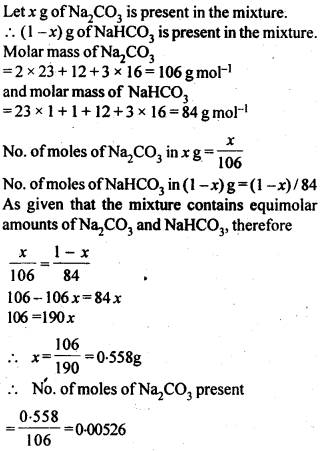
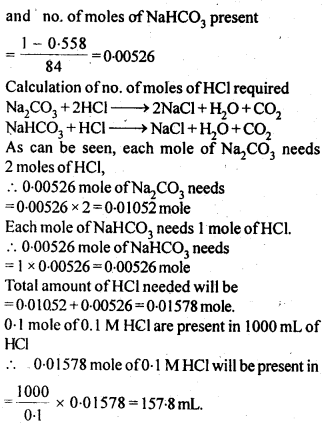
Question 7. Calculate the percentage composition in terms of mass of a solution obtained by mixing 300 g of a 25% and 400 g of a 40% solution by mass.
Answer: 300 g of 25% solution contains solute = 75 g and 400 g of 40% solution contains = 160 g solute. Then total solute = 160 + 75 = 235 g and total solution = 300 + 400 = 700 g. ∴ % of solute in the final solution = (235/700) × 100 = 33.5 % and % of water in the final solution = 100 – 33.5 = 66.5 %.
Question 8. An antifreeze solution is prepared from 222.6 g of ethylene glycol, (C2 H6O2 ) and200 g of water. Calculate the molality of the solution. If the density of the solution is 1.072 g mL-1, then what shall be the molarity of the solution?
Answer: Mass of the solute ethylene glycol, (C2 H6O2 ) = 222.6 g and molar mass of C2 H6O2 = 62 gmol-1. Now moles of the solute = 222.6/62 = 3.59 mol. Mass of the solvent = 200 g = 0.200 kg ∴Molality = 3.59/0.200 = 17.95 m
Now , total mass of the solution = 222.6 + 200 = 422.6 g and Volume of solution = 422.6 / 1.072 mL = 394.2 mL = 0.3492 L ∴ Molarity = 3.59/0.3492 = 9.11 M.
Question 9. A sample of drinking water was found to be severely contaminated with chloroform (CHCl3), supposed to be a carcinogen. The level of contamination was 15 ppm (by mass).
(i) express this in percent by mass.
(ii) determine the molality of chloroform in the water sample.
Answer: 15 ppm means 15 parts in million (106) parts by mass of solution. ∴ % by mass = (15 /106) × 100 = 15 × 10–4. Now taking 15 g Chloroform in 106 g of the solution, mass of solvent = 106 g. Molar mass of CHCl3 = 12 + 1 + 3 × 35.5 = 119.5 gmol-1 ∴ molality = (15/119.5) × (1000/106) = 1.25 × 10–4 m.
Question 10. What role does the molecular interaction play in solution of alcohol in water?
Answer: There is a strong hydrogen bond in alcohol and water molecules. On mixing them, the molecular interactions are weakened. Hence, they show positive deviation from ideal behaviour. As a result, the solution will have higher vapour pressure and lower boiling point than that of water and alcohol.
Question 11. Why do gases nearly always tend to be less soluble in liquid as the temperature is raised?
Answer: Dissolution of gas in liquid is an exothermic process. According to Le- Chatelier’s principle, the temperature is increased, equilibrium shifts backward.
Question 12. State Henry’s law and mention some of its important applications.
Answer: Henry’s law explains the effect of pressure on the solubility of a gas in liquid. According to this law, the partial pressure of any gas in a solution is directly proportional to the mole fraction of this gas or solubility. Mathematically it can be expressed as pgas ∝ xgas or pgas = kH. xgas where kH is known as Henry’s gas constant.
Important applications of Henry’s law:
- In the production of carbonated beverages.
- In the deep sea diving.
- In the function of lungs.
- For climbers or people living at high altitudes.
Question 13. The partial pressure of ethane over a saturated solution containing 6.56 × 10–2 g of ethane is 1 bar. If the solution contains 5.00 × 10–2 g of ethane, then what shall be the partial pressure of the gas?
Answer: Applying the relationship, m = kH × p. In the first case, 6.56 × 10–2 g = kH × 1 bar or kH = 6.56 × 10–2 g bar–1. In the second case, 5.00 × 10–2 g = 6.56 × 10–2 g bar–1 × p or p = 5.00 × 10–2 g/6.56 × 10–2 g bar–1 = 0.762 bar
Question 14. What is meant by positive and negative deviations from Raoult’s law and how is the sign of ΔsolH related to positive and negative deviations from Raoult’s law?
Answer: positive deviation from Raoult’s law. When the total vapour pressure for any solution is greater than that corresponding to an ideal solution of the same components, such behaviour of solutions is described as a positive deviation from Raoult’s law. For example, acetone + benzene, alcohol + water. And ΔsolH = +ve
Negative deviation from Raoult’s law. When the total vapour pressure for any solution is lower than that corresponding to an ideal solution of the same components, such behaviour of solutions is described as a negative deviation from Raoult’s law. For example, HCl + water, acetone + aniline. And ΔsolH = – ve.
Question 15. An aqueous solution of 2% non- volatile solute exerts a pressure of 1.004 bar at the normal boiling point of the solvent. What is the molecular mass of the solute?
Answer: After applying Raoult’s law 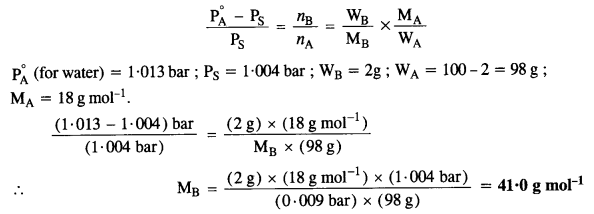
Question 16. Heptane and octane form ideal solution. At 373 K, the vapour pressure of the two liquid components are 105.2 kPa and 46.8 kPa respectively. What will be the vapour pressure of a mixture of 26.0 g of heptane and 35.0 g of octane?
Answer: Molar mass of heptane (C7H16) = 100 gmol-1 and molar mass of octane (C8H18) = 114 gmol-1. Now 26 g heptane = 26/100 = 0.26 mol and 35 g octane = 35/114 = 0.31 mol. Now X (heptane) = 0.26/(0.26 + 0.31) = 0.456 and X(octane) = 1 – 0.0456 = 0.544. According to Raoult’s law, p(heptane) = 0.456 × 105.2 kPa = 47.97 kPa and p(octane) = 0.544 × 46.8 kPa = 25.46 kPa. ∴ ptotal = 47.97 + 25.46 kPa = 73.43 kPa.
Question 17. The vapour pressure of water is 12.3 kPa at 300 K. Calculate the vapour pressure of 1 molal solution of a solute in it.
Answer: 1 molal solution means 1 mole of solute is present in 1 kg of the solvent 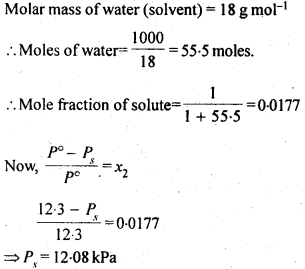
Question 18. Calculate the mass of a non- volatile solute (molar mass 40 gmol-1) which should be dissolved in 114 g octane to reduce its vapour pressure to 80%.
Answer: According to Raoult’s law 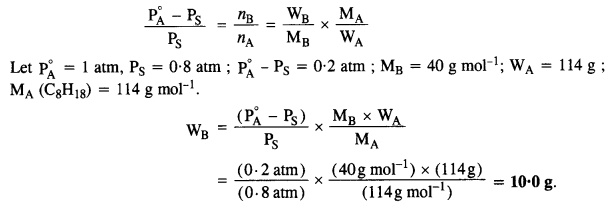
Question 19. A solution containing 30g of non-volatile solute exactly in 90 g of water has a vapour pressure of 2.8 kPa at 298 K. Further, 18g of water is then added to the solution and the new of vapour pressure becomes 2.9 kPa at 298 K. Calculate
(i) molar mass of the solute.
(ii) vapour pressure of water at 298 K.
Answer: Suppose the molar mass of the solute = M gmol-1. 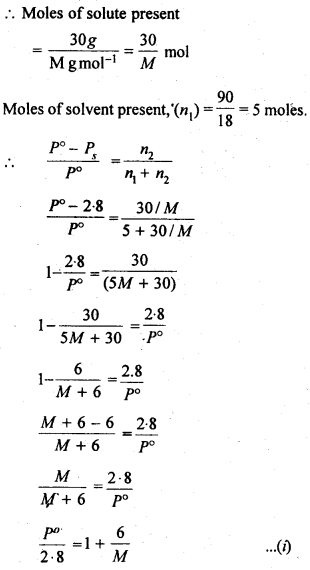
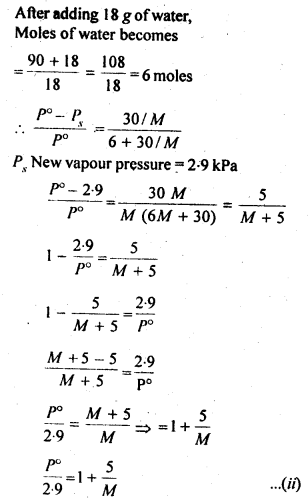

Question 20. A 5% solution (by mass) of cane sugar in water has freezing point of 271 K. Calculate the freezing point of 5% glucose in water if freezing point of pure water is 273.15 K.
Answer: Molality of sugar solution = (5/342) × (1000/100) = 0.146 and ΔTf for sugar solution = 273.15 – 271 = 2.15o ΔTf = Kf × m, ∴ Kf = 2.15/0.146 = 14.726 Molality of glucose solution = (5/180) × (1000/100) = 0.278 ∴ ΔTf (glucose) = 14.726 × 0.278 = 4.09o ∴ Freezing point of glucose solution = 273.15 – 4.09 = 269.06 K.
Question 21. Two elements A and B form compounds having formula AB2 and AB4. When dissolved in 20g of benzene (C6H6), 1 g of AB2 lowers the freezing point by 2.3 K whereas 1.0 g of AB4 lowers it by 1.3 K. The molar depression constant for benzene is 5.1 K kg mol-1. Calculate atomic masses of A and B.
Answer: 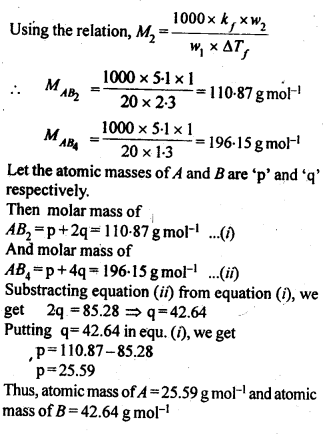
Question 22. At 300 K, 36 g glucose present per litre in its solution has osmotic pressure of 4·98 bar. If the osmotic pressure of the solution is 1·52 bar at the same temperature, what would be its concentration?
Answer: According to Vant’sHoff equation, π = CRT ∴ In the first case, 4.98 = (36/180) × R × 300 = 60 R. In the second case, 1.52 = C × R × 300. Now dividing the equation of 2nd case by the equation of 1st, we get C = 0.061M.
Question 23. Suggest the most important type of intermolecular attractive interaction in the following pairs:
(i) n-hexane and n-octane
(ii) I2 and CCl4.
(iii) NaCl04 and water
(iv) methanol and acetone
(v) acetonitrile (CH3CN) and acetone (C3H60)
Answer: (i) Both are non- polar. Hence, Intermolecular interaction in them will be London dispersion force.
(ii) same as (i)
(iii) NaClO4 produces Na+ and ClO4– ions in the solution while water is a polar molecule. Hence, Intermolecular interaction in them will be ion-dipole interaction.
(iv) Both are polar molecules. Hence, Intermolecular interactions in them will be dipole-dipole interaction.
(v) Same as (iv).
Question 24. Based on solute solvent interactions, arrange the following in order of increasing solubility in n-octane and explain. Cyclohexane, KCl, CH3OH, CH3CN.
Answer: (1) Cyclohexane and n-octane both are non- polar. Hence, they mix completely in all proportions. (2) KCl is an Ionic compound while n-octane is non- polar. Hence, KCl will not dissolve at all in n-octane.(3) CH3OH and CH3CN both are polar but CH3CN is less polar than CH3OH. As the solvent is non- polar. CH3CN will dissolve more than CH3OH in n-octane. Thus the order of solubility will be KCl < CH3OH < CH3CN < Cyclohexane.
Question 25. Amongst the following compounds, identify which are insoluble, partially soluble and highly soluble in water?
(i) phenol
(ii) toluene
(iii) formic acid
(iv) ethylene glycol
(v) chloroform
(vi) pentanol
Answer: (i) Partially soluble (because Phenol has polar – OH group but aromatic phenyl, C6H5– group is non- polar). (ii) Insoluble because toluene is non- polar while water is polar. (iii) Highly soluble because formic acid can form hydrogen bond with water. (iv) Highly soluble because ethylene glycol can form hydrogen bond with water. (v) Insoluble because Chloroform is an organic liquid. (vi) Partially soluble because -OH group is polar but the large hydrocarbon part (C5H11-)is non- polar.
Question 26. If the density of lake water is 1·25 g mL-1, and it contains 92 g of Na+ ions per kg of water, calculate the molality of Na+ ions in the lake.
Answer: No. of moles of 92 g of Na+ ions = 92 g / 23 gmol-1 = 4 mole (as atomic mass of Na = 23). As these are present in 1 kg of water. Hence, by definition, molality = 4 m.
Question 27. If the solubility product of CuS is 6 × 10–16. Calculate the maximum molarity of CuS in aqueous solution.
Answer: Maximum molarity of CuS in aqueous solution = solubility of CuS in mol L-1. If S is the solubility of CuS in mol L-1, then CuS ⇌ Cu2+ + S2–, Ksp = [Cu2+] [S2–] = S × S = S2 ∴ S2 = 6 × 10–6 or S = √6 × 10–16 = 2.45 × 10–9 mol L-1.
Question 28. Calculate the mass percentage of aspirin (C9H8O4) in acetonitrile (CH3CN) when 6.5 g of C9H8O4 is dissolved in 450 g of CH3CN.
Answer: Mass percent of Aspirin = (Mass of aspirin /Mass of aspirin + Mass of acetonitrile) × 100 = (6.5/456.5) × 100 = 1.424%.
Question 29. Nalorphene (C19H21NO3), similar to morphine, is used to combat withdrawal symptoms in narcotic users. Dose of nalorphene generally given is 1.5 mg. Calculate the mass of 1.5 x 10-3 m aqueous solution required for the above dose.
Answer: 1.5 x 10-3 m solution means that 1.5 x 10-3 mole of nalorphene is dissolved in 1 kg of water. Molar mass of C19H21NO3 is = (19 ×12) + 21 + 14 + 48 = 311 g mol-1. ∴ 1.5 × 10–3 mole of C19H21NO3 = 1.5 × 10–3 × 311 g = 0.467 g = 467 mg. ∴ Mass of solution = 1000 + 0.467 = 1000.467 g. Thus, for 467 mg of nalorphene, solution required = 1000.467 g. Hence for 1.5 mg of nalorphene, solution required = 1000.467 × 1.5/467 = 3.21 g.
Question 30. Calculate the amount of benzoic acid (C5H5COOH) required for preparing 250 mL of 0· 15 M solution in methanol.
Answer: 0.15 M solution means that 0.15 mole of benzoic acid is present in 1 L or 1000 mL of the solution. Molar mass of benzoic acid (C5H5COOH) = 72 + 5 + 12 + 32 + 1 = 122 gmol-1. ∴ 0.15 mole of benzoic acid = 0.15 × 122 g = 18.3 g. Thus, 1000 ml of the solution contain benzoic acid = 18.3 g. ∴ 250 ml of the solution will contain benzoic acid = (18.3 / 1000) × 250 = 4.575 g.
Question 31. The depression in freezing point of water observed for the same amount of acetic acid, trichloroacetic acid and trifluoroacetic acid increases in the order given above. Explain briefly.
Answer: The depression in freezing point are in the order: acetic acid < trichloroacetic acid < trifluoroacetic acid 
Fluorine, being most electronegative, has the highest value of electron withdrawing Inductive effect, as a result it is the strongest acid. While acetic acid is the weakest acid. As trifluoroacetic acid ionised to a large extent while acetic acid ionises to the minimum extent in their solution. Greater the ions produced, greater is the depression in freezing point. Hence, the depression in the freezing is maximum for the fluoroacetic acid and minimum for acetic acid.
Question 32. Calculate the depression in the freezing point of water when 10g of CH3CH2CHClCOOH is added to 250g of water. Ka = 1.4 x 1o-3 Kg = 1.86 K kg mol-1.
Answer: Molar mass of CH3CH2CHCl– COOH = 15 + 14 + 13 + 35.5 + 45 = 122.5 gmol-1 and 10 g of CH3CH2CHCl– COOH = 10/122.5 mole = 8.16 × 10–2 mole. ∴ molarity of the solution = (8.16 × 10–2 mol / 250 g) × 1000 g kg–1 = 0.3264 M. If α is the degree of dissociation of CH3CH2 CHCl– COOH, then 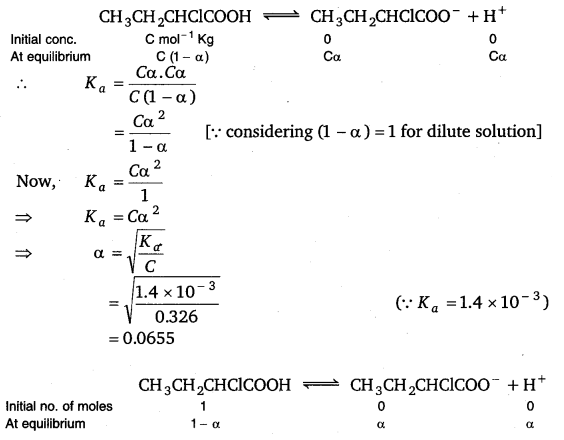
Total moles = 1– α + α + α = 1 + α or ¡ = (1 + α)/1 = 1 + α = 1 + 0.065 = 1.065. Or ΔTf = i. Kf. m = 1.065 × 1.86 × 0.3264 = 0.65o.
Question 33. 19.5g of CH2FCOOH is dissolved in 500g of water. The depression in the freezing point of water observed is 1.0°C. Calculate the van’s Hoff factor and dissociation constant of fluoroacetic acid.
Answer: Here, w2 = 19.5 g, w1 = 500 g, Kf = 1.86 K kg mol-1, (ΔTf)obs = 1.0o. Molar mass (M2 ) of CH2FCOOH = 24 + 3 + 19 + 32 = 78 g mol-1
ΔTf = i Kf m 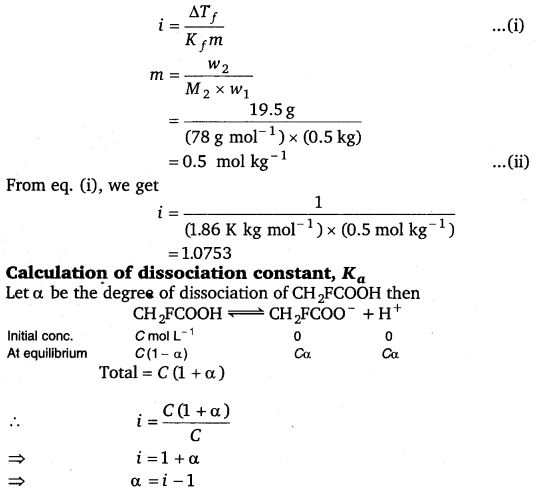
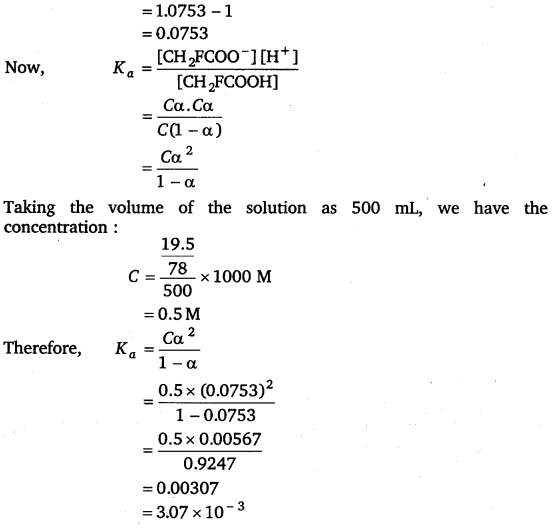
Question 34. Vapour pressure of water at 293 K is 17·535 mm Hg. Calculate the vapour pressure of water at 293 K when 25 g of glucose is dissolved in 450 g of water.
Answer: As we know according to Raoult’s law 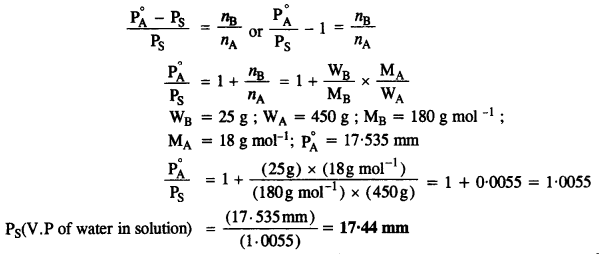
Question 35. Henry’s law constant for the molality of methane in benzene at 298 K is 4.27 x 105 mm Hg. Calculate the solubility of methane in benzene at 298 K under 760 mm Hg.
Answer: Here, kH = 4.27 × 105 mm, p = 760 mm. According to Henry’s law, p = kH × χ or χ = p/kH = 760 mm / 4.27 x 105 mm = 1.78 × 10–3. As mass fraction of methane in benzene is termed as solubility. ∴ solubility of methane = 1.78 × 10–3
Question 36. 100g of liquid A (molar mass 140 g mol-1) was dissolved in 1000g of liquid B (molar mass 180g mol-1). The vapour pressure of pure liquid B was found to be 500 torr. Calculate the vapour pressure of pure liquid A and its vapour pressure in the solution if the total vapour pressure of the solution is 475 torr.
Answer: No. of moles of liquid A (solute) = 100 g / 140 gmol-1 = 5/7 mole. No. of moles of liquid B (solvent) = 1000 g / 180 gmol-1 = 50/9 mole. Mole fraction of A in the solution (χA) = (5/7) /{(5/7) + (50/9)} = 45/395 = 0.114. ∴ Mole fraction of B in the solution (χB) = 1 – 0.114 = 0.886.
Also given, pBo = 500 torr. Now applying Raoult’s law, pA = χA.pAo = 0.114 × pAo —– (i) and pB = χB.pBo = 0.886 × 500 = 443 torr. As ptotal = pA + pB or 475 = 0.114 × pAo + 443 or pAo = (475 – 443)/0.114 = 280.7 torr. Substituting the value of pAo, in equation (i) we get pA = 0.114 × 280.7 torr = 32 torr.
Question 37. Vapour pressures of pure acetone and chloroform at 328 K are 741.8 mm Hg and 632.8 mm Hg respectively. Assuming that they form ideal solution over the entire range of composition, plot Ptotal, Pchlroform and Pacetone as a function of χacetone. The experimental data observed for different compositions of mixtures is: 
Plot this data also on the same graph paper. Indicate whether it has positive deviation or negative deviation from the ideal solution.
Answer: 
After observing the above graph, it is found that the dips of ptotal is directing downward, hence the solution shows negative deviation from the ideal behaviour.
Question 38. Benzene and toluene form ideal solution over the entire range of composition. The vapour pressure of pure benzene and toluene at 300 K are 50.71 mm Hg and 32.06 mm Hg respectively. Calculate the mole fraction of benzene in vapour phase if 80g of benzene is mixed with 100g of toluene.
Answer: Molar mass of benzene (C6H6) = 78 gmol-1. Molar mass of toluene (C7H8) = 92 gmol-1. No.of moles in 80 g benzene = 80/78 = 1.026 mol. No. of moles in 100 g of toluene = 100 / 92 = 1.087 mol. In the solution, the mole fraction of benzene = 1.026/(1.026 + 1.087) = 0.486. Now mole fraction of toluene = 1 – 0.486 = 0.514. Given PoBenzene = 50.71 mm and potoluene = 32.06 mm.
Applying Raoult’s law, pbenzene = Xbenzene. Pobenzene = 0.486 × 50.71 mm = 24.65 mm. Ptoluene = Xtoluene . Potoluene = 0.514 × 32.06 mm = 16.48 mm. Now, mole fraction of benzene in the vapour phase = pbenzene /(pbenzene + ptoluene) = 24.65/(24.65 + 16.48) = 24.65 / 41.13 = 0.60
Question 39. The air is a mixture of a number of gases. The major components are oxygen and nitrogen with an approximate proportion of 20% is to 79% by volume at 298 K. The water is in equilibrium with air at a pressure of 10 atm. At 298 K if Henry’s law constants for oxygen and nitrogen are 3.30 x 107 mm and 6.51 x 107 mm respectively, calculate the composition of these gases in water.
Answer: Total pressure of air in equilibrium with water = 10 atm. As air contains 20% oxygen and 79% nitrogen by volume, ∴ partial pressure of oxygen (pO2) = (20/100) × 10 atm = 2 atm = 2 × 760 mm = 1520 mm. And partial pressure of nitrogen (pN2) = (79/100) × 10 atm = 7.9 atm = 7.9 × 760 mm = 6004 mm. kH (O2) = 3.30 × 107 mm and kH (N2) = 6.51 × 107 mm.
Applying Henry’s law, pO2 = kH × xO2 or xO2 = pO2/kH = 1520 mm / 3.30 × 107 mm = 4.61 × 10–5. Again, pN2 = kH × xN2 or xN2 = pN2/kH = 6004 mm/6.51 × 107 mm = 9.22 × 10–5.
Question 40. Determine the amount of CaCl2 (i = 2.47) dissolved in 2.5 litre of water such that its osmotic pressure is 0.75 atm at 27°C.
Answer: π = i CRT = i n R T/V or n = (n × V) / i × R × T = (0.75 atm × 2.5 L) / (2.47 × 0.0281 L atm mol–1K–1 × 300 K) = 0.0308 mole. Molar mass of CaCl2 = 40 + 2 × 35.5 = 111 gmol-1 ∴ Amount dissolved = 0.0308 × 111 g = 3.42 g.
Question 41. Determine the osmotic pressure of a solution prepared by dissolving 25 mg of K2SO4 in 2 litre of water at 25°C, assuming that it is completely dissociated.
Answer: K2SO4 dissolved = 25 mg = 0.025 g. Volume of solution = 2 L and T = 25oC = 298 K. Molar mass of K2SO4 = 2 × 39 + 32 + 4 × 16 = 174 gmol-1. As K2SO4 dissociates completely as K2SO4 → 2K+ + SO42— and in this reaction, produced ions = 3 ∴ i = 3. Now π = i CRT = i n R T/V = i × (w/M) × (1/V) × RT = 3 × (0.025 g / 174 gmol-1) × (1/2L) × 0.0821 L atm mol–1K–1 × 298 K = 5.27 × 10–3 atm.

